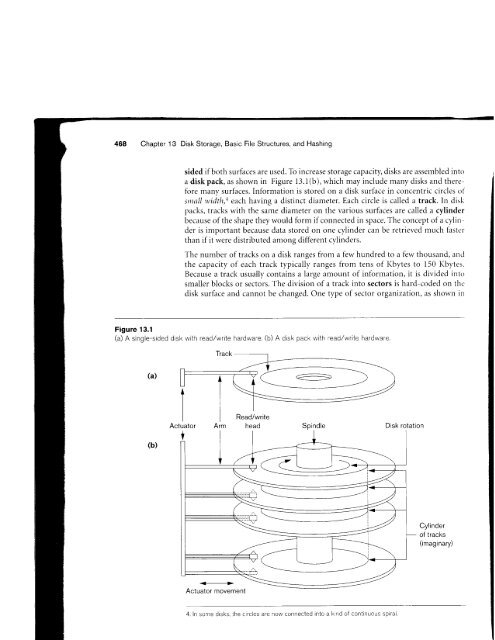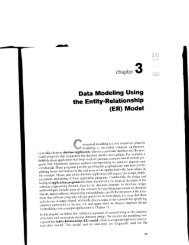13.1 through 13.5, 13.10 and 13.11
13.1 through 13.5, 13.10 and 13.11
13.1 through 13.5, 13.10 and 13.11
You also want an ePaper? Increase the reach of your titles
YUMPU automatically turns print PDFs into web optimized ePapers that Google loves.
Chapter 13 Disk Storage, Basic File Structures, <strong>and</strong> Hashingsided ifboth surfaces are used. To increase storage capacity, disks are assernbled intoa disk pack, as shown in Figure <strong>13.1</strong>(b), which may include many disks <strong>and</strong> thereforernany surfaces. Information is stored on a disk surface in concentric circles ofsrnoll width,a each having a distinct diarneter. Each circle is called a track. In diskpacks, tracks with the same diameter on the various surfaces are called a cylinderbecause of the shape they would form if connected iu space. The concept of a cylinderis important because data stored on one cylinder can be retrieved much fasterthan if it were distributed among different cylinders.The number of tracks on a disk ranges from a few hundred to a few thous<strong>and</strong>, anclthe capacity of each track typically ranges from tens of Kbytes to 150 Kbytes.Because a track usually contailrs a large amount of information, it is divided intosmaller blocks or sectors. The division of a track into sectors is hard-coded on thcdisk surface <strong>and</strong> cannot be changed. One type of sector organization, as shown inFigure <strong>13.1</strong>(a) A single-sided disk with readlwrite hardware, (b) A disk pack with readlwrite hardware(a)lIActuatort IIArmRead/writeneao Spindle Disk rotation(b)Cylinderof tracks(imaginary)4, In some disks, the c rcles are now connected into a k nd of continuous spiral














